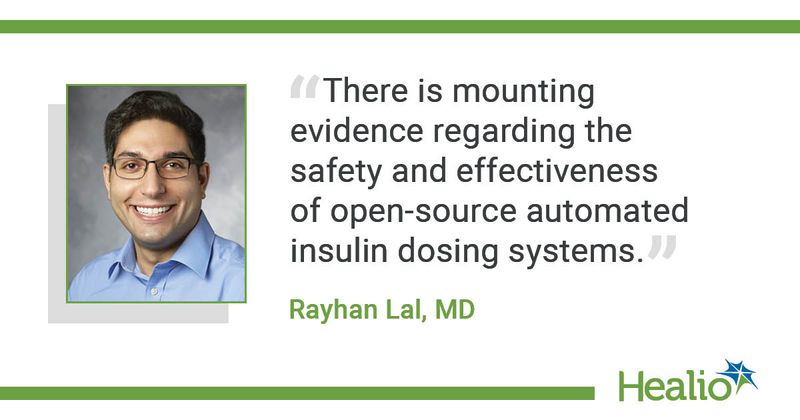Consensus group: Providers, policies must support DIY artificial pancreas use
Health care providers should facilitate and support people with diabetes who choose to use a do-it-yourself automated insulin delivery system, working together with patients to set “realistic” goals and minimize any hypoglycemia risk.
In an international consensus statement published in The Lancet Diabetes & Endocrinology, the authors also called for local policies that support open-source automated insulin delivery systems as “fostering ethical medical principles and evidence-based medical treatment.”

“There is mounting evidence regarding the safety and effectiveness of open-source automated insulin dosing systems,” Rayhan Lal, MD, an adult and pediatric endocrinologist at Stanford University School of Medicine, told Healio. “There has been a lack of guidance for health care providers in supporting individuals using these systems. When you do not have guidance, it leads to uncertainty and indecision. There are also perceived ethical and legal concerns for those providing care for people using unregulated technology, even though many providers use medications off-label all the time.”
DIY systems, also known as open-source automated insulin delivery systems, represent closed-loop systems using an insulin pump, continuous glucose monitor and an open-source algorithm. They are considered an off-label use of diabetes devices and are not approved by the FDA. Despite that, the authors estimate more than 10,000 people with diabetes worldwide are using an open-source artificial pancreas; at least 20% of users are children or adolescents. With uptake steadily increasing globally, there remains no professional guidance available for health care professionals to support their use in clinical settings
An international group of 44 health care professionals and four legal experts with clinical experience and expertise on open-source automated insulin delivery systems provided a consensus of guidance for providers, with support from the International Diabetes Federation, the International Society for Pediatric and Adolescent Diabetes, and other diabetes professional organizations.
The authors highlight 10 key points:
- Scientific evidence from real-world data (self-report, physician-report and device data), with support from in silico data, demonstrates open-source automated insulin delivery systems are safe and effective treatment options for people with diabetes. “They can increase time in range, reduce glycemic variability and hypoglycemia and hyperglycemia in various age groups, genders and socioeconomic communities,” Lal said in an interview.
- Alongside commercial automated insulin delivery systems, open-source automated insulin delivery systems have the potential to help a wide population of people with diabetes, including those with suboptimal or optimal glycemic self-management and people who are looking to ease their own day-to-day burden.
- Health care professionals should support people with diabetes and their caregivers who might choose to manage their diabetes with an open-source system. “Autonomy must be respected,” Lal said. “We need to respect the rights of people with diabetes and their caregivers to make informed decisions. Heath care providers should support people with diabetes who chose to manage their disease with an open-source automated insulin delivery system.”
- Health care professionals should attempt to learn about all treatment options that might benefit people with diabetes, including available open-source automated insulin delivery systems. “It is reasonable to provide a comprehensive overview of all available automated insulin delivery system options and educate people with diabetes and their caregivers on the availability and existing evidence, if the potential risks and benefits are clearly explained,” the authors wrote.
- Health care professionals unfamiliar with the specifics of open-source systems or those who have legal or regulatory concerns in their location should consider a cooperation with or a referral to other health care professionals who can provide support. “They should not turn anyone away and say there is no one willing to help you, because that is simply not true,” Lal said.
- All developers, including commercial systems, should fully disclose how they operate to enable providers, people with diabetes, and caregivers to make informed decisions and understand the benefits and limitations of all automated insulin delivery systems.
- Open-source systems have not undergone the same regulatory evaluations as commercially available medical technologies. There is no commercial technical support, but extensive community support is available.
- Clarifying the user’s goals and setting realistic expectations are crucial to the success of DIY systems. To ensure maximum safety, users of open-source systems should be guided to “optimize their systems for hypoglycemia prevention before pursuing tight glycemic control.”
- Providers are not advised to universally recommend open-source automated insulin delivery systems over available and accessible commercial systems. “We also do not recommend that health care professionals violate local law or organizational governance,” the authors wrote, adding that if ethical and effective treatment is deemed unlawful or occupies an uncertain and problematic regulatory position, “then the regional policies should be clarified.”
- Real-world evidence should be considered by device regulators and streamlined regulatory processes to evaluate and test algorithm updates should be adopted.
As Healio previously reported, the FDA signaled its support for customizable solutions for people with diabetes in mid-2019 with two new device approvals designed to improve automated insulin delivery. The Tandem Diabetes Care t:Slim X2 insulin pump, an alternate controller enabled insulin infusion pump (ACE pump), is the first interoperable pump approved for children and adults with diabetes by the FDA, meaning it can be used with different components that make up diabetes therapy systems, although in practice this has not occurred. The device was the first to be classified under a new de novo premarket review pathway. The FDA also granted breakthrough device designation for a personalized, closed-loop insulin pump system in development by Medtronic.
Tidepool is working on an interoperable automated glycemic controller based on the Loop algorithm and has announced partnerships with Insulet and Medtronic.
For more information:
Rayhan Lal, MD, can be reached at inforay@stanford.edu.
